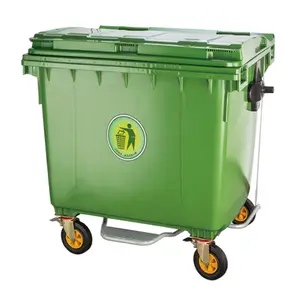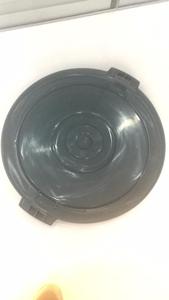(12498 products available)



















































































































































































































A plastic waste container is a container made from plastic materials designed to hold and collect various types of waste. There are different types of plastic waste containers, each designed to manage specific types of waste. They help in the proper disposal, recycling, and treatment of waste, reducing environmental impact and promoting sustainability. Some common types include.
Plastic waste containers come in different sizes and colors to promote proper waste segregation and management. For instance, yellow containers are mostly used for medical waste, while black containers are used for general waste.
The design of plastic waste containers focuses on aesthetics, functionality, and promoting proper waste disposal. The following elements are crucial to their design.
Shape and Size:
Most plastic waste containers have cylindrical, rectangular, or cubic shapes. The cylindrical and rectangular shapes are easy to handle and empty. The size of the waste container depends on its intended use. For example, office waste containers are small compared to industrial waste containers.
Material:
Plastic waste containers are made from high-density polyethylene (HDPE) plastic material. This material is durable and can withstand harsh weather conditions. It is also easy to clean and maintain. Some plastic waste containers are made from recycled plastic waste to promote sustainability.
Lid and Opening:
A waste container with a lid prevents the smell of waste from coming out and keeps pests away. The opening should be wide enough to allow easy disposal of waste. Some containers have flap lids that open when one pushes them to allow waste disposal and close automatically.
Handles and Wheels:
Handles make it easy to move the waste container from one place to another. The handles should be strong enough for this purpose. Waste containers for outdoor use, especially in places like hospitals and restaurants, have wheels to facilitate movement.
Color Coding and Labeling:
Plastic waste containers are often color-coded and labeled to promote proper waste disposal. Different colors represent different types of waste, such as organic waste, recyclable waste, and hazardous waste. Labeling helps users identify the right container for the waste they want to dispose of.
Ventilation:
Some plastic waste containers have ventilated designs to reduce odor and gas buildup. These containers are suitable for wet waste, such perishable food waste. The ventilation helps air circulate and keeps the contained waste from becoming moldy.
Plastic waste containers are used in different places to ensure cleanliness and safety. They are important for managing trash to keep the environment clean. They help dispose of waste properly, preventing pollution and promoting recycling. They are essential for keeping areas tidy and protecting the environment.
Scenario 1: Residential Areas
In residential areas, plastic waste containers are placed along the streets and outside homes to collect regular household trash. They ensure that people can throw their waste in a covered bin to keep the environment clean and prevent foul odors or pests.
Scenario 2: Parks and Recreational Areas
In parks, plastic waste containers are available to collect trash from picnics and activities. Some may have separate sections for recyclable items like plastic bottles and aluminum cans to help visitors reduce their environmental impact.
Scenario 3: Commercial Establishments
Restaurants and shopping malls use larger plastic waste containers to manage garbage from many customers. They place these bins in strategic locations to ensure cleanliness and the proper disposal of food waste, packaging, and other refuse.
Scenario 4: Industrial Sites
Industries use robust plastic waste containers for regular trash and hazardous materials. They have clear labeling and separate compartments to ensure the safe disposal of dangerous substances and compliance with safety regulations.
Scenario 5: Healthcare Facilities
Hospitals require specialized plastic waste containers to prevent infection. These bins are used to collect used medical supplies, syringes, and other potentially infectious waste. They have tight seals and biohazard symbols to indicate their contents and prevent exposure.
Scenario 6: Construction Sites
Construction sites use plastic waste containers to collect debris, old materials, and garbage. They are durable and can handle heavy waste, keeping the site safe and clean and making it easier to dispose of or recycle the waste.
Scenario 7: Educational Institutions
Schools and universities have plastic waste containers in classrooms, cafeterias, and outdoor spaces. Some bins are labeled for trash and recyclables to teach students about proper waste segregation and the importance of recycling.
Scenario 8: Events and Festivals
Organizers of public events set up many plastic waste containers to manage the large amounts of trash generated. They may provide clear instructions on how to use them, especially for compostable items, to promote sustainable practices during the event.
Scenario 9: Transportation
Plastic waste containers are used in airports, train stations, and bus terminals to keep travel areas clean. These containers are designed to handle various waste from passengers, often with features to prevent littering and promote recycling.
From a business perspective, choosing the right plastic waste container is crucial. It ensures compliance with industry standards, promotes safety, and optimizes waste management efficiency. Here are some key factors that business buyers should consider when selecting plastic waste containers.
Compliance with regulations
Business buyers need to ensure that the plastic waste containers comply with relevant industry regulations and standards. They should choose containers that meet the guidelines set by organizations such as the Occupational Safety and Health Administration (OSHA) and the Environmental Protection Agency (EPA). These regulations may pertain to the handling of hazardous waste, labeling requirements, and spill containment.
Container durability
The waste plastic containers business buyers choose should be durable and made to last. These containers should be able to withstand the demands of the commercial environment. Business buyers should go for containers that have features like reinforced construction, heavy-duty lids, and robust handles. These features enhance the longevity and reliability of the containers.
Safety features
Safety features are important when selecting plastic waste containers. Business buyers should look for containers that have secure sealing mechanisms. These prevent leaks and spills. Additionally, containers with ergonomic handles and anti-slip features promote safe handling and reduce the risk of accidents.
Container capacity
Business buyers need to assess the waste management needs of their organization. They should then select plastic waste containers that are of the right capacity. Choosing containers with sufficient capacity to accommodate the expected waste volume. It prevents overflow and maintains a clean and organized workspace.
Q1: What is the main purpose of plastic waste containers?
A1: The main purpose of these containers is to collect, store, and dispose of different types of waste materials.
Q2: What are the benefits of using plastic waste containers?
A2: Plastic waste containers are light in weight, durable, and resistant to corrosion. They also provide cost-effective solutions for waste management.
Q3: What types of plastic are usually used in making these containers?
A3: Most commonly, high-density polyethylene (HDPE) and polypropylene (PP) are used to make plastic waste containers.
Q4: How can one choose the right plastic waste container?
A4: While choosing a plastic waste container, factors like the type of waste, capacity, durability, and environmental considerations should be kept in mind.
Q5: How can one maintain a plastic waste container?
A5: The containers should be cleaned regularly with mild detergent and water. Also, disinfectants should be used for odor control and to maintain hygiene.